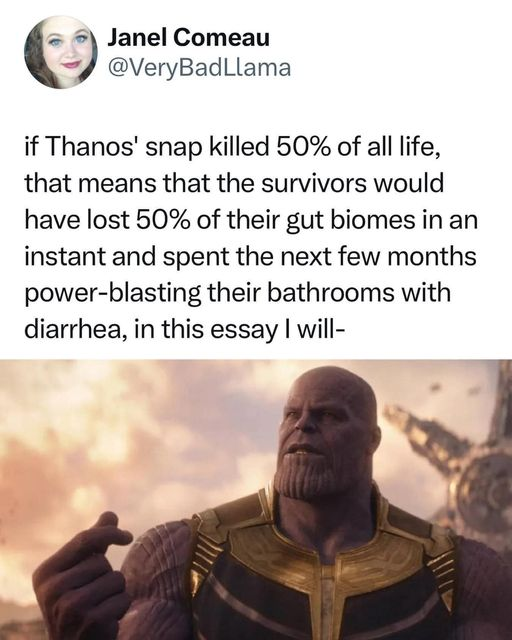this post was submitted on 13 Nov 2024
650 points (93.8% liked)
Science Memes
11047 readers
3446 users here now
Welcome to c/science_memes @ Mander.xyz!
A place for majestic STEMLORD peacocking, as well as memes about the realities of working in a lab.

Rules
- Don't throw mud. Behave like an intellectual and remember the human.
- Keep it rooted (on topic).
- No spam.
- Infographics welcome, get schooled.
This is a science community. We use the Dawkins definition of meme.
Research Committee
Other Mander Communities
Science and Research
Biology and Life Sciences
- [email protected]
- [email protected]
- [email protected]
- [email protected]
- [email protected]
- [email protected]
- [email protected]
- [email protected]
- [email protected]
- [email protected]
- [email protected]
- [email protected]
- [email protected]
- [email protected]
- [email protected]
- [email protected]
- [email protected]
- [email protected]
- [email protected]
- [email protected]
- [email protected]
- [email protected]
- [email protected]
- [email protected]
- !reptiles and [email protected]
Physical Sciences
- [email protected]
- [email protected]
- [email protected]
- [email protected]
- [email protected]
- [email protected]
- [email protected]
- [email protected]
- [email protected]
Humanities and Social Sciences
Practical and Applied Sciences
- !exercise-and [email protected]
- [email protected]
- !self [email protected]
- [email protected]
- [email protected]
- [email protected]
Memes
Miscellaneous
founded 2 years ago
MODERATORS
you are viewing a single comment's thread
view the rest of the comments
view the rest of the comments

That's not how percentages work
Say, there exists 2 humans and 98 bacteria. Consider all cells of a human one life.
50% of ALL life doesn't care which species the life is, and therefore there's a chance that 50 bacteria die. The probability of that happening is 98C50 / 100C50 = 98! 50! 50! / (100! 50! 48!) = (50)(49) / ((100)(99)) = 0.247
For my previous argument, I did not actually do the math. Now that I have done a little bit, the probability seems to converge at 25%
Obviously, this is based on the interpretation of "all life". For my interpretation, "all life" includes every life in a single set, and apply the 50% snap to that. For some others however, it may be interpreted as each species in their own set, and the 50% snap is applied on each set individually.
But if there are 7 billion humans and n bacteria, and 50% of them are snapped, wouldn't approximately 3.5 billion humans and n/2 bacteria be snapped?
The problem is the ambiguity of the statement. Is it 50% of each species? Or is it 50% of all life as one set?
If it's the former case, then sure 3.5b humans and n/2 bacteria gets snapped.
But if it's the latter case, we group all 7b and n bacteria into one set and snap half of them. This 50% can consist of 50% humans + 50% bacteria, but there's also a chance for it to include 0% humans + 100% bacteria. Therefore, the amount of humans snap is a random variable instead of a constant.